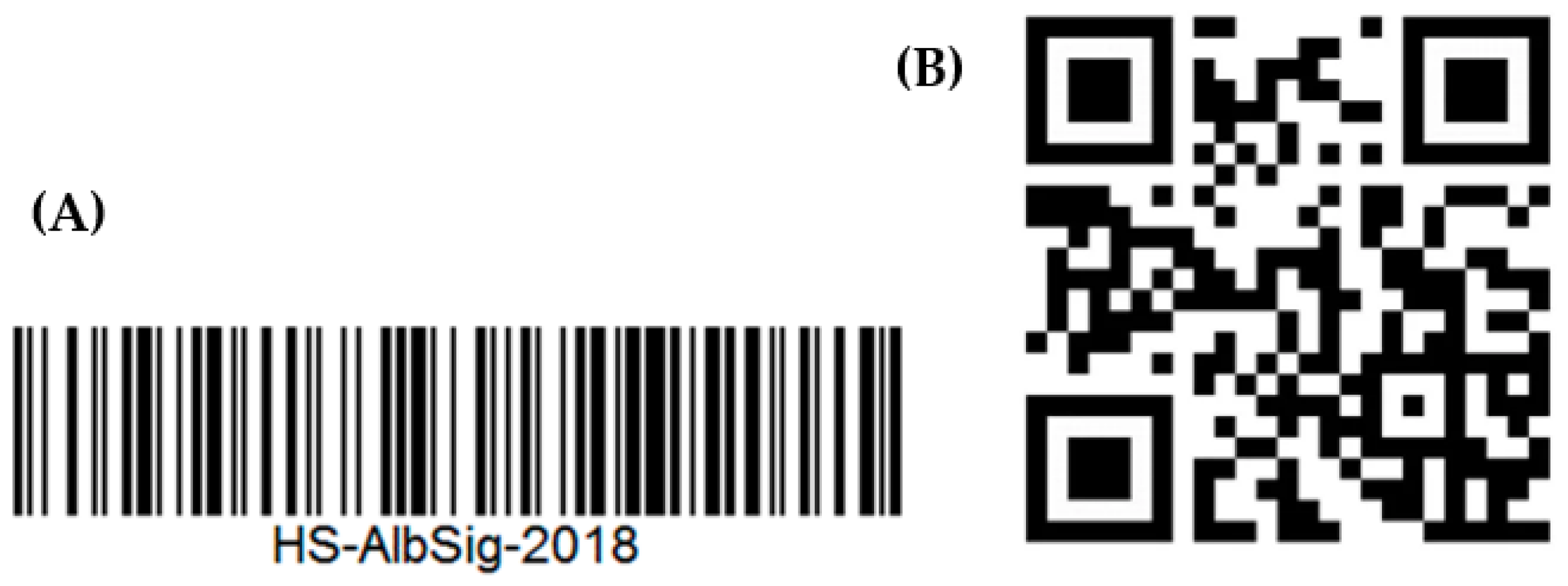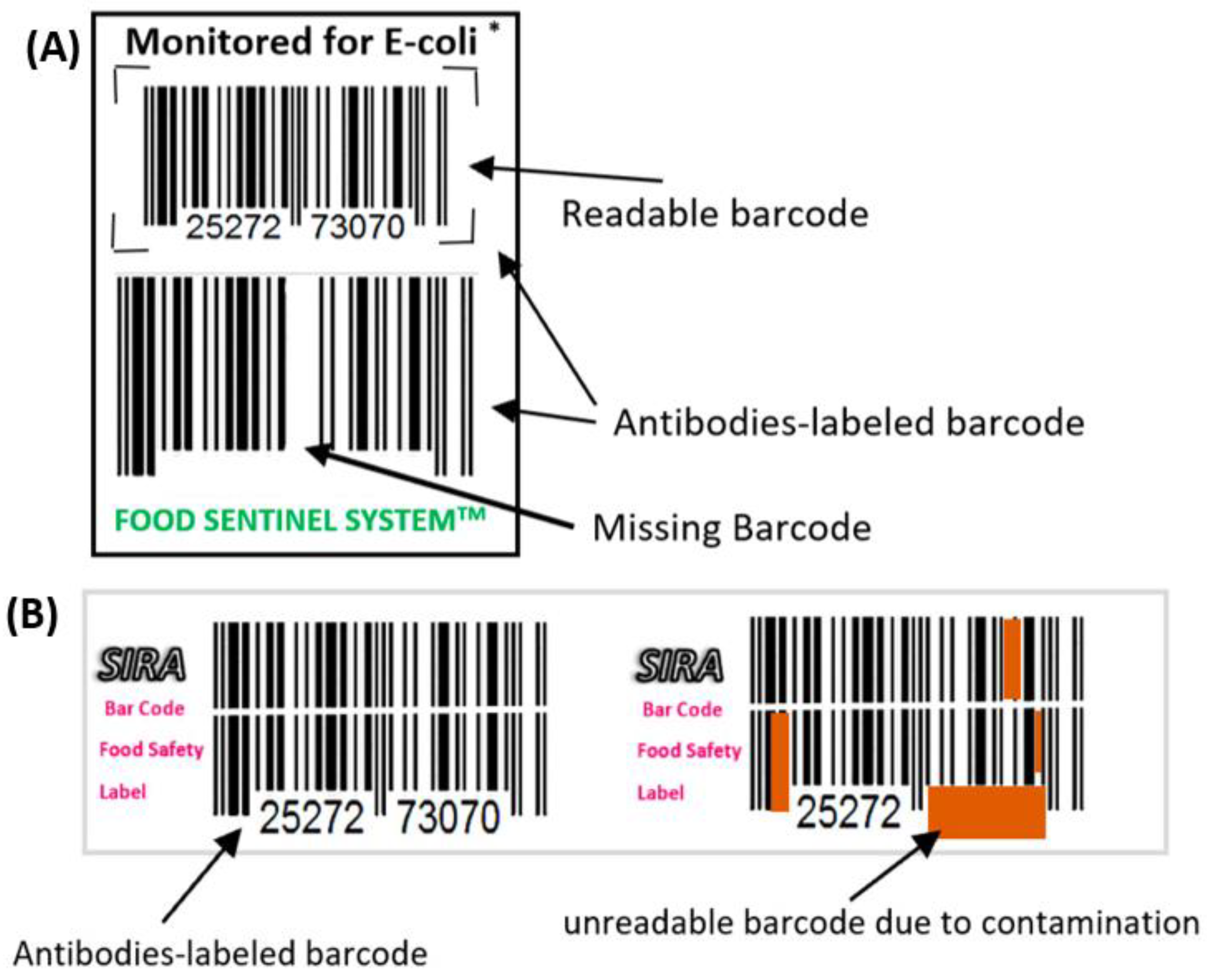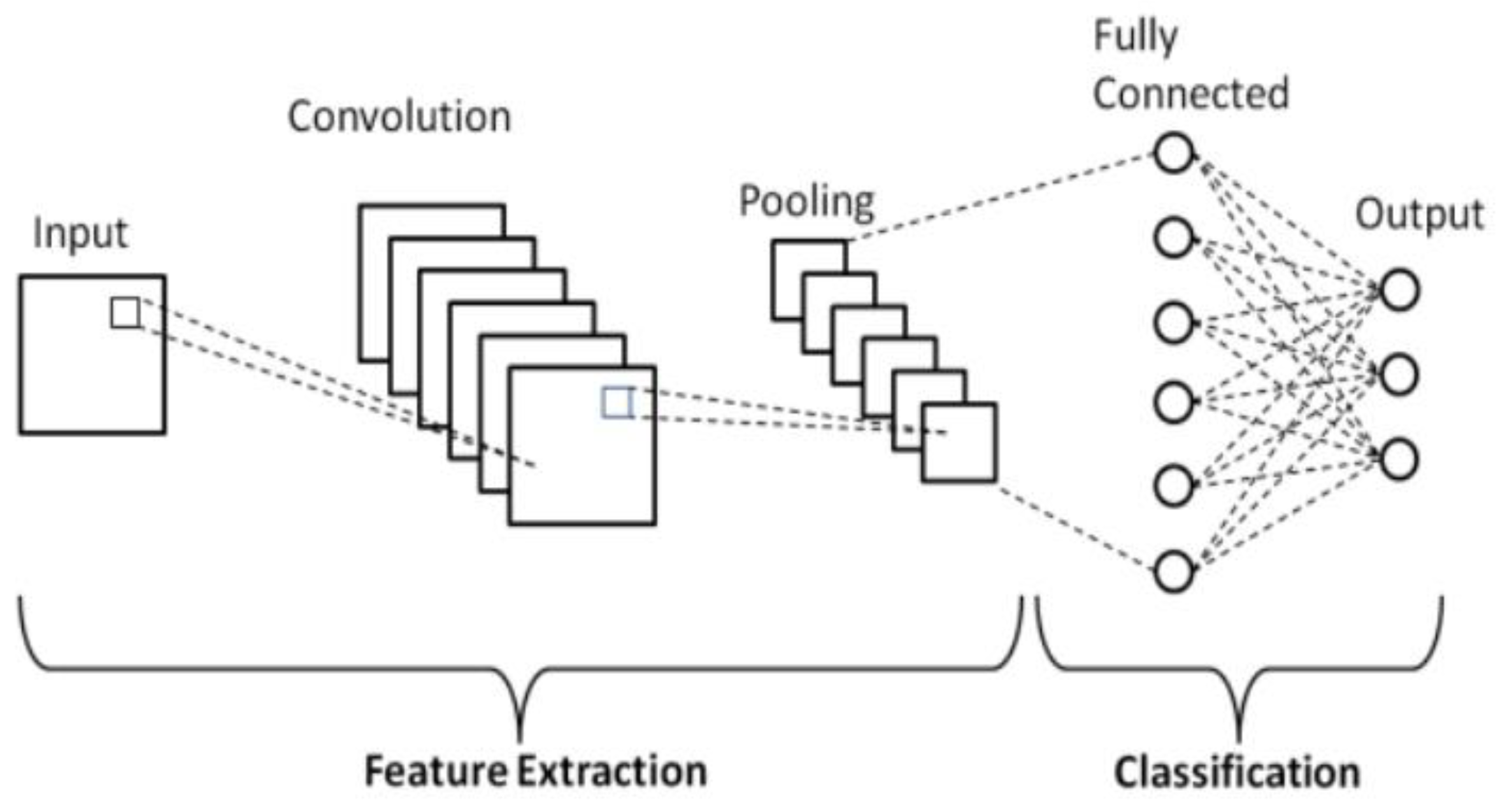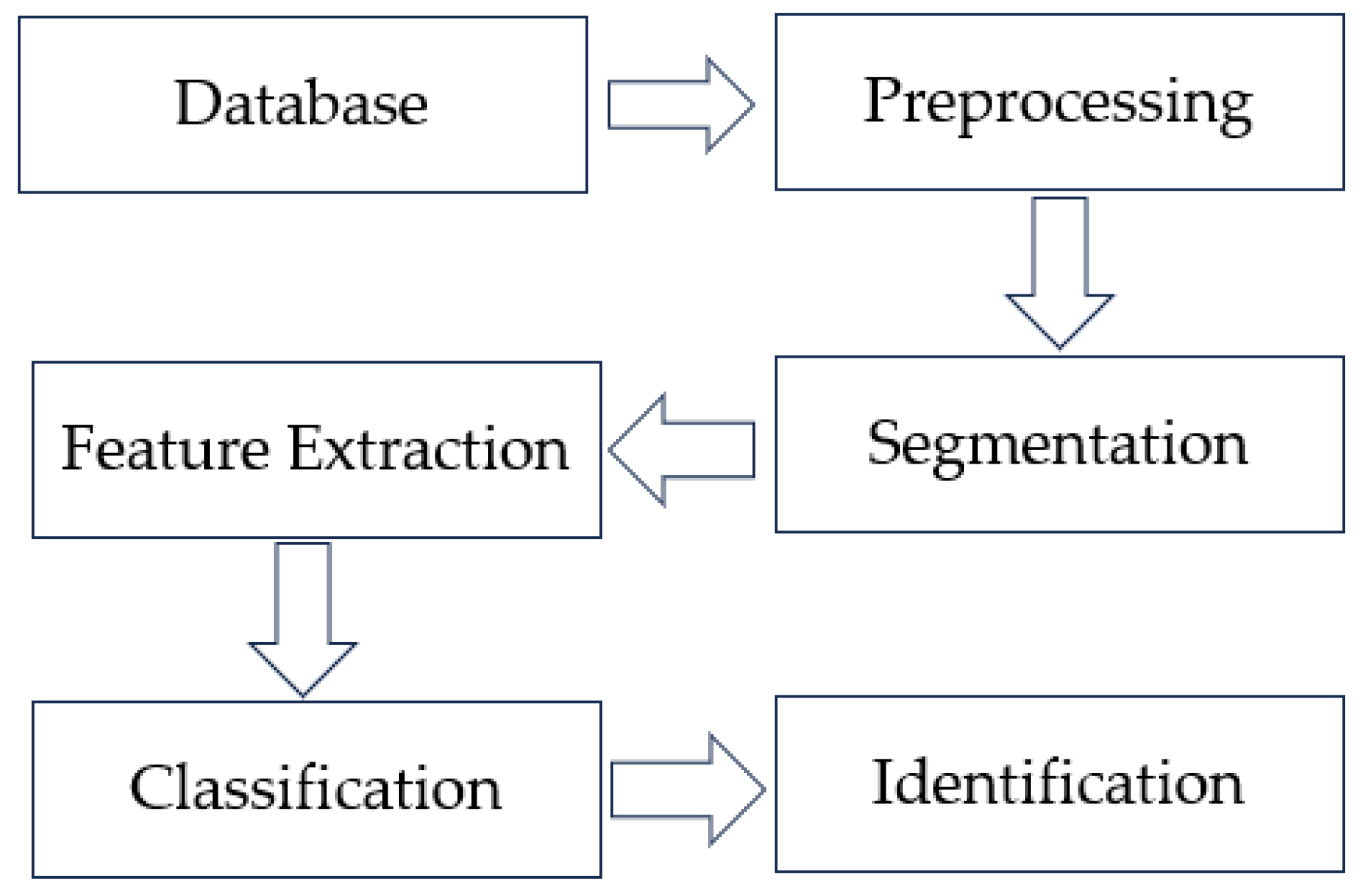Recent Advance of Intelligent Packaging Aided by Artificial Intelligence for Monitoring Food Freshness
Abstract
1. Introduction
2. Intelligent Packaging Technology Overview
2.1. Intelligent Packaging Technology Definition
2.2. The Link between Intelligent Packaging Technology and Intelligent Packaging
3. Classification and Application of Intelligent Packaging Technology
3.1. Direct Factor Detection Category
3.1.1. Freshness Monitoring Technology
3.1.2. Maturity Monitoring Technology
3.2. Indirect Factor Detection Category
3.2.1. Time–Temperature Indicators
3.2.2. Leak Indicators
3.3. Information Aids
3.3.1. Bar Code Technology
3.3.2. Radio Frequency Identification Technology (RFID)
3.3.3. Augmented Reality (AR)
4. Artificial Intelligence Technology Used in Food Freshness Testing
4.1. Deep Learning-Based Food Freshness Detection
4.2. Computer Vision-Based Food Freshness Detection
5. Conclusions and Future Perspectives
Author Contributions
Funding
Data Availability Statement
Conflicts of Interest
References
- Food Safety. Available online: https://www.who.int/news-room/fact-sheets/detail/food-safety (accessed on 19 February 2022).
- Estimating the Burden of Foodborne Diseases. Available online: https://www.who.int/activities/estimating-the-burden-of-foodborne-diseases (accessed on 5 March 2022).
- Yildirim, S. Active packaging for food biopreservation. In Protective Cultures, Antimicrobial Metabolites and Bacteriophages for Food and Beverage Biopreservation; Woodhead Publishing: Sawston, UK, 2011; pp. 460–489. [Google Scholar] [CrossRef]
- Liu, D.; Cui, Z.; Shang, M.; Zhong, Y. A colorimetric film based on polyvinyl alcohol/sodium carboxymethyl cellulose incorporated with red cabbage anthocyanin for monitoring pork freshness. Food Packag. Shelf Life 2021, 28, 100641. [Google Scholar] [CrossRef]
- Yildirim, S.; Röcker, B.; Pettersen, M.K.; Nilsen-Nygaard, J.; Ayhan, Z.; Rutkaite, R.; Radusin, T.; Suminska, P.; Marcos, B.; Coma, V. Active Packaging Applications for Food. Compr. Rev. Food Sci. Food Saf. 2017, 17, 165–199. [Google Scholar] [CrossRef] [PubMed]
- Wyrwa, J.; Barska, A. Innovations in the food packaging market: Active packaging. Eur. Food Res. Technol. 2017, 243, 1681–1692. [Google Scholar] [CrossRef]
- Suppakul, P.; Miltz, J.; Sonneveld, K.; Bigger, S. Active Packaging Technologies with an Emphasis on Antimicrobial Packaging and its Applications. J. Food Sci. 2003, 68, 408–420. [Google Scholar] [CrossRef]
- Dodero, A.; Escher, A.; Bertucci, S.; Castellano, M.; Lova, P. Intelligent Packaging for Real-Time Monitoring of Food-Quality: Current and Future Developments. Appl. Sci. 2021, 11, 3532. [Google Scholar] [CrossRef]
- Poyatos-Racionero, E.; Ros-Lis, J.V.; Vivancos, J.-L.; Martínez-Máñez, R. Recent advances on intelligent packaging as tools to reduce food waste. J. Clean. Prod. 2018, 172, 3398–3409. [Google Scholar] [CrossRef]
- Müller, P.; Schmid, M. Intelligent Packaging in the Food Sector: A Brief Overview. Foods 2019, 8, 16. [Google Scholar] [CrossRef]
- Liu, D.; Zhang, C.; Pu, Y.; Chen, S.; Li, H.; Zhong, Y. Novel colorimetric films based on polyvinyl alcohol/sodium carboxymethyl cellulose doped with anthocyanins and betacyanins to monitor pork freshness. Food Chem. 2023, 404, 134426. [Google Scholar] [CrossRef]
- Kalpana, S.; Priyadarshini, S.R.; Leena, M.M.; Moses, J.A.; Anandharamakrishnan, C. Intelligent packaging: Trends and applications in food systems. Trends Food Sci. Technol. 2019, 93, 145–157. [Google Scholar] [CrossRef]
- Yam, K.L.; Takhistov, P.T.; Miltz, J. Intelligent Packaging: Concepts and Applications. J. Food Sci. 2005, 70, R1–R10. [Google Scholar] [CrossRef]
- Bagchi, A.; He, T. Intelligent sensing and packaging of foods for enhancement of shelf life: Concepts and applications. Int. J. Sci. Eng. Res. 2012, 3, 1–13. [Google Scholar]
- Realini, C.E.; Marcos, B. Active and intelligent packaging systems for a modern society. Meat Sci. 2014, 98, 404–419. [Google Scholar] [CrossRef]
- Janjarasskul, T.; Suppakul, P. Active and intelligent packaging: The indication of quality and safety. Crit. Rev. Food Sci. Nutr. 2017, 58, 808–831. [Google Scholar] [CrossRef] [PubMed]
- Matindoust, S.; Baghaei-Nejad, M.; Abadi, M.H.S.; Zou, Z.; Zheng, L.-R. Food quality and safety monitoring using gas sensor array in intelligent packaging. Sens. Rev. 2016, 36, 169–183. [Google Scholar] [CrossRef]
- Schaefer, D.; Cheung, W.M. Smart Packaging: Opportunities and Challenges. Procedia CIRP 2018, 72, 1022–1027. [Google Scholar] [CrossRef]
- Sohail, M.; Sun, D.-W.; Zhu, Z. Recent developments in intelligent packaging for enhancing food quality and safety. Crit. Rev. Food Sci. Nutr. 2018, 58, 2650–2662. [Google Scholar] [CrossRef] [PubMed]
- Wang, Z. Intelligent Packaging Technology and Its Application. Packag. J. 2018, 10, 27–33. [Google Scholar] [CrossRef]
- Li, H.; Wang, J.; He, Z.; Li, S. Research progress on intelligent packaging in quality and safety monitoring of animal derived food products. Food Ferment. Ind. 2019, 45, 272–279. [Google Scholar] [CrossRef]
- Chong, L.P.J.; Xiong, P. Development and Applications of Intelligent Packaging Technology. Packag. Eng. 2017, 38, 149–154. [Google Scholar] [CrossRef]
- Cheng, Y. Application Trend of Augmented Reality in Intelligent Packaging. Packag. Eng. 2018, 39, 27–30. [Google Scholar] [CrossRef]
- Liu, C.Z.G.; Song, X.; Lu, J.; Cao, Y.; Shi, J. Application and Development Trend of Intelligent Packaging. Packag. Eng. 2019, 40, 80–86. [Google Scholar] [CrossRef]
- Fang, Z.; Zhao, Y.; Warner, R.D.; Johnson, S.K. Active and intelligent packaging in meat industry. Trends Food Sci. Technol. 2017, 61, 60–71. [Google Scholar] [CrossRef]
- Nopwinyuwong, A.; Trevanich, S.; Suppakul, P. Development of a novel colorimetric indicator label for monitoring freshness of intermediate-moisture dessert spoilage. Talanta 2010, 81, 1126–1132. [Google Scholar] [CrossRef] [PubMed]
- Beaudry, R. MAP as a basis for active packaging. Active packaging for fruits and vegetables. In Intelligent and Active Packaging for Fruits and Vegetables, 1st ed.; Wilson, C.L., Ed.; CRC Press: Boca Raton, FL, USA, 2007; pp. 31–55. [Google Scholar] [CrossRef]
- Inada, T.N.; Hiroshi; Tsubouchi, N.; Shinohara, Y. Food Animal Freshness Degree of Maturation Evaluating Device, and Freshness Degree of Maturation Evaluating Method. 2021. Available online: https://patentscope2.wipo.int/search/en/detail.jsf?docId=WO2021177433 (accessed on 5 March 2022).
- Fuertes, G.; Soto, I.; Carrasco, R.; Vargas, M.; Sabattin, J.; Lagos, C. Intelligent Packaging Systems: Sensors and Nanosensors to Monitor Food Quality and Safety. J. Sens. 2016, 2016, 4046061. [Google Scholar] [CrossRef]
- Park, Y.W.; Kim, S.M.; Lee, J.Y.; Jang, W. Application of biosensors in smart packaging. Mol. Cell. Toxicol. 2015, 11, 277–285. [Google Scholar] [CrossRef]
- Meng, X.; Kim, S.; Puligundla, P.; Ko, S. Carbon dioxide and oxygen gas sensors-possible application for monitoring quality, freshness, and safety of agricultural and food products with emphasis on importance of analytical signals and their transformation. J. Korean Soc. Appl. Biol. Chem. 2014, 57, 723–733. [Google Scholar] [CrossRef]
- Co, C. CARBOTEC TR-PT, Carbon Dioxide Sensor. Center Gesellschaft Fur. 2018. Available online: https://www.centec.de/sensors/food-dairy/carbotec-tr-pt (accessed on 5 March 2022).
- Anusankari, S.; Ganesh, A.B.; Subasri, R.; Deepa, N. Optical determination of carbon dioxide and oxygen by a fluorescent membrane to evaluate the freshness of meat products. Instrum. Sci. Technol. 2019, 47, 640–665. [Google Scholar] [CrossRef]
- Ezati, P.; Tajik, H.; Moradi, M.; Molaei, R. Intelligent pH-sensitive indicator based on starch-cellulose and alizarin dye to track freshness of rainbow trout fillet. Int. J. Biol. Macromol. 2019, 132, 157–165. [Google Scholar] [CrossRef]
- Ezati, P.; Tajik, H.; Moradi, M. Fabrication and characterization of alizarin colorimetric indicator based on cellulose-chitosan to monitor the freshness of minced beef. Sens. Actuators B Chem. 2019, 285, 519–528. [Google Scholar] [CrossRef]
- Cavanna, D.; Zanardi, S.; Dall’Asta, C.; Suman, M. Ion mobility spectrometry coupled to gas chromatography: A rapid tool to assess eggs freshness. Food Chem. 2018, 271, 691–696. [Google Scholar] [CrossRef]
- Cheng, J.-H.; Sun, D.-W.; Qu, J.-H.; Pu, H.-B.; Zhang, X.-C.; Song, Z.; Chen, X.; Zhang, H. Developing a multispectral imaging for simultaneous prediction of freshness indicators during chemical spoilage of grass carp fish fillet. J. Food Eng. 2016, 182, 9–17. [Google Scholar] [CrossRef]
- Diaz, L.F.M.; Wrobel, K.; Escobosa, A.R.C.; Ojeda, D.A.A.; Wrobel, K. Identification of potential indicators of time-dependent tequila maturation and their determination by selected ion monitoring gas chromatography–mass spectrometry, using salting-out liquid–liquid extraction. Eur. Food Res. Technol. 2019, 245, 1421–1430. [Google Scholar] [CrossRef]
- Lee, J.-H.; Morita, A.; Kuroshima, M.; Kawamura, S.; Koseki, S. Development of a novel time–temperature integrator/indicator (TTI) based on the maillard reaction for visual monitoring of melon (Cucumis melo L.) maturity during cultivation. J. Food Meas. Charact. 2018, 12, 2899–2904. [Google Scholar] [CrossRef]
- Mataragas, M.; Bikouli, V.C.; Korre, M.; Sterioti, A.; Skandamis, P.N. Development of a microbial Time Temperature Indicator for monitoring the shelf life of meat. Innov. Food Sci. Emerg. Technol. 2018, 52, 89–99. [Google Scholar] [CrossRef]
- Biegańska, M.; Gwiazdowska, D.; Kozak, W.; Marchwińska, K. The use of TTI indicators for quality monitoring of freshly squeezed juices. In Proceedings of the International Forum on Agri–Food Logistics II Domestic Scientific Conference Agrologistyka, Poznań, Poland, 1 September 2014; Available online: https://www.researchgate.net/publication/269688109 (accessed on 5 March 2022).
- Kim, J.U.; Ghafoor, K.; Ahn, J.; Shin, S.; Lee, S.H.; Shahbaz, H.M.; Shin, H.-H.; Kim, S.; Park, J. Kinetic modeling and characterization of a diffusion-based time-temperature indicator (TTI) for monitoring microbial quality of non-pasteurized angelica juice. LWT 2016, 67, 143–150. [Google Scholar] [CrossRef]
- Zeng, J.; Roberts, S.; Xia, Y. Nanocrystal-Based Time–Temperature Indicators. Chem.-Eur. J. 2010, 16, 12559–12563. [Google Scholar] [CrossRef]
- Zhang, C.; Yin, A.-X.; Jiang, R.; Rong, J.; Dong, L.; Zhao, T.; Sun, L.-D.; Wang, J.; Chen, X.; Yan, C.-H. Time–Temperature Indicator for Perishable Products Based on Kinetically Programmable Ag Overgrowth on Au Nanorods. ACS Nano 2013, 7, 4561–4568. [Google Scholar] [CrossRef]
- Yoshida, C.M.P.; Junior, E.N.O.; Franco, T.T. Chitosan tailor-made films: The effects of additives on barrier and mechanical properties. Packag. Technol. Sci. 2008, 22, 161–170. [Google Scholar] [CrossRef]
- Lee, B.-S.; Shin, H.-S. Polymer-based time-temperature indicator for high temperature processed food products. Food Sci. Biotechnol. 2012, 21, 1483–1487. [Google Scholar] [CrossRef]
- Kreyenschmidt, J.; Christiansen, H.; Hübner, A.; Raab, V.; Petersen, B. A novel photochromic time-temperature indicator to support cold chain management. Int. J. Food Sci. Technol. 2010, 45, 208–215. [Google Scholar] [CrossRef]
- Galagan, Y.; Su, W.-F. Fadable ink for time–temperature control of food freshness: Novel new time–temperature indicator. Food Res. Int. 2008, 41, 653–657. [Google Scholar] [CrossRef]
- Wanihsuksombat, C.; Hongtrakul, V.; Suppakul, P. Development and characterization of a prototype of a lactic acid–based time–temperature indicator for monitoring food product quality. J. Food Eng. 2010, 100, 427–434. [Google Scholar] [CrossRef]
- Zheng, G.Q.J.; Feng, Q. Preparation of Time-Temperature Indicator Reaction System Based on Glucoamylase. J. Food Sci. 2013, 34, 82–85. [Google Scholar] [CrossRef]
- Brizio, A.P.D.R.; Prentice, C. Development of Aa New Time Temperature Indicator for Enzymatic Validation of Pasteurization of Meat Products. J. Food Sci. 2015, 80, M1271–M1276. [Google Scholar] [CrossRef]
- Wu, D.; Pan, J.Z.; Chen, J.C.; Ye, X.Q.; Liu, D.H. Dynamics Research of Time-Temperature Indicating System Based on Alkaline Lipase. Appl. Mech. Mater. 2013, 469, 422–427. [Google Scholar] [CrossRef]
- Rahman, M.S. Report on the First International Conference on Food Properties (iCFP1-2014). Int. J. Food Prop. 2014, 17, 2117. [Google Scholar] [CrossRef]
- Kim, K.; Kim, E.; Lee, S.J. New enzymatic time–temperature integrator (TTI) that uses laccase. J. Food Eng. 2012, 113, 118–123. [Google Scholar] [CrossRef]
- Lu, L.; Zheng, W.; Lv, Z.; Tang, Y. Development and Application of Time-temperature Indicators Used on Food during the Cold Chain Logistics. Packag. Technol. Sci. 2012, 26, 80–90. [Google Scholar] [CrossRef]
- Yusufu, D.; Mills, A. A colourimetric vacuum air-pressure indicator. Analyst 2019, 144, 5947–5952. [Google Scholar] [CrossRef]
- Ye, M.; Qian, C.; Sun, W.; He, L.; Jia, J.; Dong, Y.; Zhou, W. Dye colour switching by hydride-terminated silicon particles and its application as an oxygen indicator. J. Mater. Chem. C 2016, 4, 4577–4583. [Google Scholar] [CrossRef]
- Mills, A.; Hazafy, D. Nanocrystalline SnO2-based, UVB-activated, colourimetric oxygen indicator. Sens. Actuators B Chem. 2009, 136, 344–349. [Google Scholar] [CrossRef]
- Lee, S.-K.; Sheridan, M.; Mills, A. Novel UV-Activated Colorimetric Oxygen Indicator. Chem. Mater. 2005, 17, 2744–2751. [Google Scholar] [CrossRef]
- Lawrie, K.; Mills, A.; Hazafy, D. Simple inkjet-printed, UV-activated oxygen indicator. Sens. Actuators B Chem. 2013, 176, 1154–1159. [Google Scholar] [CrossRef]
- Khankaew, S.; Boonsupthip, W.; Nandhivajrin, C.; Suppakul, P. Effect of nano-semiconductors and sacrificial electron donors on color transition of a novel UV-activated bio-oxygen indicator. In Proceedings of the Iapri World Conference on Packaging, Melbourne, Australia, 15 June 2014; Available online: https://www.researchgate.net/publication/306034968 (accessed on 5 March 2022).
- Jang, N.Y.; Won, K. New pressure-activated compartmented oxygen indicator for intelligent food packaging. Int. J. Food Sci. Technol. 2013, 49, 650–654. [Google Scholar] [CrossRef]
- Won, K.; Jang, N.Y.; Jeon, J. A Natural Component-Based Oxygen Indicator with In-Pack Activation for Intelligent Food Packaging. J. Agric. Food Chem. 2016, 64, 9675–9679. [Google Scholar] [CrossRef]
- Vu, C.H.T.; Won, K. Leaching-Resistant Carrageenan-Based Colorimetric Oxygen Indicator Films for Intelligent Food Packaging. J. Agric. Food Chem. 2014, 62, 7263–7267. [Google Scholar] [CrossRef]
- Vu, C.H.T.; Won, K. Novel water-resistant UV-activated oxygen indicator for intelligent food packaging. Food Chem. 2013, 140, 52–56. [Google Scholar] [CrossRef]
- Vu, C.H.T.; Won, K. Bioinspired molecular adhesive for water-resistant oxygen indicator films. Biotechnol. Prog. 2013, 29, 513–519. [Google Scholar] [CrossRef]
- Manthou, V.; Vlachopoulou, M. Bar-code technology for inventory and marketing management systems: A model for its development and implementation. Int. J. Prod. Econ. 2001, 71, 157–164. [Google Scholar] [CrossRef]
- Ghaani, M.; Cozzolino, C.A.; Castelli, G.; Farris, S. An overview of the intelligent packaging technologies in the food sector. Trends Food Sci. Technol. 2016, 51, 1–11. [Google Scholar] [CrossRef]
- SIRA Technologies. Available online: http://www.ncf-net.org/patents/pdf/SIRA-2002.pdf (accessed on 21 March 2020).
- Falagán, N.; Terry, L.A. Recent Advances in Controlled and Modified Atmosphere of Fresh Produce. Johns. Matthey Technol. Rev. 2018, 62, 107–117. [Google Scholar] [CrossRef]
- Lee, S.J.; Rahman, A.M. Intelligent packaging for food products. In Innovations in Food Packaging; Academic Press: Cambridge, MA, USA, 2014; pp. 171–209. [Google Scholar]
- Beshai, H.; Sarabha, G.K.; Rathi, P.; Alam, A.U.; Deen, M.J. Freshness Monitoring of Packaged Vegetables. Appl. Sci. 2020, 10, 7937. [Google Scholar] [CrossRef]
- Costa, C.; Antonucci, F.; Pallottino, F.; Aguzzi, J.; Sarriá, D.; Menesatti, P. A Review on Agri-food Supply Chain Traceability by Means of RFID Technology. Food Bioprocess Technol. 2012, 6, 353–366. [Google Scholar] [CrossRef]
- Forouzandeh, M.; Karmakar, N.C. Chipless RFID tags and sensors: A review on time-domain techniques. Wirel. Power Transf. 2015, 2, 62–77. [Google Scholar] [CrossRef]
- Nunes-Silva, P.; Hrncir, M.; Guimarães, J.T.F.; Arruda, H.; Costa, L.; Pessin, G.; Siqueira, J.O.; de Souza, P.; Imperatriz-Fonseca, V.L. Applications of RFID technology on the study of bees. Insectes Sociaux 2018, 66, 15–24. [Google Scholar] [CrossRef]
- Sarac, A.; Absi, N.; Dauzère-Pérès, S. A literature review on the impact of RFID technologies on supply chain management. Int. J. Prod. Econ. 2010, 128, 77–95. [Google Scholar] [CrossRef]
- Kumari, L.; Narsaiah, K.; Grewal, M.; Anurag, R. Application of RFID in agri-food sector. Trends Food Sci. Technol. 2015, 43, 144–161. [Google Scholar] [CrossRef]
- Athauda, T.; Karmakar, N.C. Review of RFID-based sensing in monitoring physical stimuli in smart packaging for food-freshness applications. Wirel. Power Transf. 2019, 6, 161–174. [Google Scholar] [CrossRef]
- Bibi, F.; Guillaume, C.; Gontard, N.; Sorli, B. A review: RFID technology having sensing aptitudes for food industry and their contribution to tracking and monitoring of food products. Trends Food Sci. Technol. 2017, 62, 91–103. [Google Scholar] [CrossRef]
- Shafiq, Y.; Gibson, J.S.; Kim, H.; Ambulo, C.P.; Ware, T.H.; Georgakopoulos, S.V. A Reusable Battery-Free RFID Temperature Sensor. IEEE Trans. Antennas Propag. 2019, 67, 6612–6626. [Google Scholar] [CrossRef]
- Lorite, G.S.; Selkälä, T.; Sipola, T.; Palenzuela, J.; Jubete, E.; Viñuales, A.; Cabañero, G.; Grande, H.J.; Tuominen, J.; Uusitalo, S.; et al. Novel, smart and RFID assisted critical temperature indicator for supply chain monitoring. J. Food Eng. 2017, 193, 20–28. [Google Scholar] [CrossRef]
- Trebar, M.; Lotrič, M.; Fonda, I. Use of RFID temperature monitoring to test and improve fish packing methods in styrofoam boxes. J. Food Eng. 2015, 159, 66–75. [Google Scholar] [CrossRef]
- Nair, R.; Perret, E.; Tedjini, S.; Barron, T. A humidity sensor for passive chipless RFID applications. In Proceedings of the IEEE International Conference on RFID-Technologies and Applications (RFID-TA), Nice, France, 5–7 November 2012; pp. 29–33. [Google Scholar] [CrossRef]
- Quintero, A.V.; Molina-Lopez, F.; Smits, E.C.P.; Danesh, E.; Brand, J.v.D.; Persaud, K.; Oprea, A.; Barsan, N.; Weimar, U.; de Rooij, N.F.; et al. Smart RFID label with a printed multisensor platform for environmental monitoring. Flex. Print. Electron. 2016, 1, 025003. [Google Scholar] [CrossRef]
- Feng, Y.; Xie, L.; Chen, Q.; Zheng, L.-R. Low-Cost Printed Chipless RFID Humidity Sensor Tag for Intelligent Packaging. IEEE Sens. J. 2014, 15, 3201–3208. [Google Scholar] [CrossRef]
- Shao, B.; Amin, Y.; Chen, Q.; Liu, R.; Zheng, L.-R. Directly Printed Packaging-Paper-Based Chipless RFID Tag with Coplanar $LC$ Resonator. IEEE Antennas Wirel. Propag. Lett. 2013, 12, 325–328. [Google Scholar] [CrossRef]
- Wang, Y.; Yan, C.; Cheng, S.-Y.; Xu, Z.-Q.; Sun, X.; Xu, Y.-H.; Chen, J.-J.; Jiang, Z.; Liang, K.; Feng, Z.-S. Flexible RFID Tag Metal Antenna on Paper-Based Substrate by Inkjet Printing Technology. Adv. Funct. Mater. 2019, 29, 1902579. [Google Scholar] [CrossRef]
- Yung, R.; Khoo-Lattimore, C. New realities: A systematic literature review on virtual reality and augmented reality in tourism research. Curr. Issues Tour. 2017, 22, 2056–2081. [Google Scholar] [CrossRef]
- Das, H.; Milgram, P.; Takemura, H.; Utsumi, A.; Kishino, F. Augmented reality: A class of displays on the reality-virtuality continuum. In Proceedings of the Telemanipulator and Telepresence Technologies, Boston, MA, USA, 1 January 1995; pp. 282–292. [Google Scholar] [CrossRef]
- Liu, D.; Zhang, C.; Pu, Y.; Chen, S.; Liu, L.; Cui, Z.; Zhong, Y. Recent Advances in pH-Responsive Freshness Indicators Using Natural Food Colorants to Monitor Food Freshness. Foods 2022, 11, 1884. [Google Scholar] [CrossRef]
- Zhu, J.; Ren, C. Analysis of the Effect of Artificial Intelligence on Role Cognition in the Education System. Occup. Ther. Int. 2022, 2022, 1781662. [Google Scholar] [CrossRef]
- Zhou, L.; Zhang, C.; Liu, F.; Qiu, Z.; He, Y. Application of Deep Learning in Food: A Review. Compr. Rev. Food Sci. Food Saf. 2019, 18, 1793–1811. [Google Scholar] [CrossRef]
- Palakodati, S.S.S.; Chirra, V.R.; Dasari, Y.; Bulla, S. Fresh and Rotten Fruits Classification Using CNN and Transfer Learning. Rev. D’intelligence Artif. 2020, 34, 617–622. [Google Scholar] [CrossRef]
- Kazi, A.; Panda, S.P. Determining the freshness of fruits in the food industry by image classification using transfer learning. Multimedia Tools Appl. 2022, 81, 7611–7624. [Google Scholar] [CrossRef]
- Guo, L.; Wang, T.; Wu, Z.; Wang, J.; Wang, M.; Cui, Z.; Ji, S.; Cai, J.; Xu, C.; Chen, X. Portable Food-Freshness Prediction Platform Based on Colorimetric Barcode Combinatorics and Deep Convolutional Neural Networks. Adv. Mater. 2020, 32, e2004805. [Google Scholar] [CrossRef]
- Mohi-Alden, K.; Omid, M.; Firouz, M.S.; Nasiri, A. Design and evaluation of an intelligent sorting system for bell pepper using deep convolutional neural networks. J. Food Sci. 2021, 87, 289–301. [Google Scholar] [CrossRef]
- de Santana, F.B.; Neto, W.B.; Poppi, R.J. Random forest as one-class classifier and infrared spectroscopy for food adulteration detection. Food Chem. 2019, 293, 323–332. [Google Scholar] [CrossRef] [PubMed]
- Voulodimos, A.; Doulamis, N.; Doulamis, A.; Protopapadakis, E. Deep Learning for Computer Vision: A Brief Review. Comput. Intell. Neurosci. 2018, 2018, 7068349. [Google Scholar] [CrossRef] [PubMed]
- Harnsoongnoen, S.; Jaroensuk, N. The grades and freshness assessment of eggs based on density detection using machine vision and weighing sensor. Sci. Rep. 2021, 11, 16640. [Google Scholar] [CrossRef] [PubMed]
- Sarkar, T.; Mukherjee, A.; Chatterjee, K.; Shariati, M.A.; Rebezov, M.; Rodionova, S.; Smirnov, D.; Dominguez, R.; Lorenzo, J.M. Comparative Analysis of Statistical and Supervised Learning Models for Freshness Assessment of Oyster Mushrooms. Food Anal. Methods 2021, 15, 917–939. [Google Scholar] [CrossRef]
- Anil, A.; Gupta, H.; Arora, M. Computer vision based method for identification of freshness in mushrooms. In Proceedings of the International Conference on Issues and Challenges in Intelligent Computing Techniques (ICICT), Ghaziabad, India, 27–28 September 2019; Volume 1, pp. 1–4. [Google Scholar] [CrossRef]
- Bhargava, A.; Bansal, A. Fruits and vegetables quality evaluation using computer vision: A review. J. King Saud Univ.-Comput. Inf. Sci. 2021, 33, 243–257. [Google Scholar] [CrossRef]








| Status | Type | Metabolites | Shelf Life (20–25 °C) | Evaluation Method | Reference | |
|---|---|---|---|---|---|---|
| Indicators | Sensor | |||||
| Solid | Vegetable | Oxygen | 3–30 days | Optical sensor by fluorescence, colorimeter based on pH | Electrochemical sensor, laser | [30] |
| Solid | Fruits | Oxygen | 2–20 days | Optical sensor by fluorescence, colorimeter based on pH | Electrochemical sensor, laser | [26] |
| Solid | Food Animals | ATP-associated compound | 2–3 days | [28] | ||
| Glucose/ lactic acid | Colorimeter based on pH | Electrochemical sensor by redox reaction | [26] | |||
| Carbon dioxide | Colorimeter based on pH | Electrochemical sensor by silicon-based polymers | [30] | |||
| Biogenic amines | Color-changing pH-sensitive dyes | Electrochemical sensor by enzyme redox reaction | [31] | |||
| Liquid | Dairy product | Glucose/ lactic acid | 1 day | Colorimeter based on pH | - | [29] |
| Jelly | Fermented food | Glucose/ lactic acid | 7–180 days | Colorimeter based on pH | Electrochemical sensor by redox reaction | [32] |
| Carbon dioxide | Colorimeter based on pH | Electrochemical sensor by silicon-based polymers | [26] | |||
Disclaimer/Publisher’s Note: The statements, opinions and data contained in all publications are solely those of the individual author(s) and contributor(s) and not of MDPI and/or the editor(s). MDPI and/or the editor(s) disclaim responsibility for any injury to people or property resulting from any ideas, methods, instructions or products referred to in the content. |
© 2023 by the authors. Licensee MDPI, Basel, Switzerland. This article is an open access article distributed under the terms and conditions of the Creative Commons Attribution (CC BY) license (https://creativecommons.org/licenses/by/4.0/).
Share and Cite
Li, X.; Liu, D.; Pu, Y.; Zhong, Y. Recent Advance of Intelligent Packaging Aided by Artificial Intelligence for Monitoring Food Freshness. Foods 2023, 12, 2976. https://doi.org/10.3390/foods12152976
Li X, Liu D, Pu Y, Zhong Y. Recent Advance of Intelligent Packaging Aided by Artificial Intelligence for Monitoring Food Freshness. Foods. 2023; 12(15):2976. https://doi.org/10.3390/foods12152976
Chicago/Turabian StyleLi, Xiaoxuan, Danfei Liu, Yumei Pu, and Yunfei Zhong. 2023. "Recent Advance of Intelligent Packaging Aided by Artificial Intelligence for Monitoring Food Freshness" Foods 12, no. 15: 2976. https://doi.org/10.3390/foods12152976
APA StyleLi, X., Liu, D., Pu, Y., & Zhong, Y. (2023). Recent Advance of Intelligent Packaging Aided by Artificial Intelligence for Monitoring Food Freshness. Foods, 12(15), 2976. https://doi.org/10.3390/foods12152976







